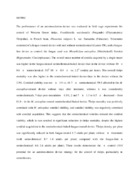| dc.description.abstract | The performance of an autoinoculation device was evaluated in field cage experiments for
control of Western flower thrips, Frankliniella occidentalis (Pergande) (Thysanoptera:
Thripidae), in French bean, Phaseolus vulgaris L. var. Samantha (Fabaceae). Treatments
consisted of a fungus-treated device with and without semiochemical (Lurem-TR), and a fungusfree device as control; the fungus used was Metarhizium anisopliae (Metchnikoff) Sorokin
(Hypocreales: Clavicipitaceae). The overall mean number of conidia acquired by a single insect
was higher in the fungus-treated semiochemical-baited device than in the device without 10 ×
0.6 ± semiochemical: 5.04
10 × 0.4 ± vs. 2.24
conidia per insect. The overall thrips
mortality was also higher in the semiochemical-baited device than in the device without the
3.5%. Conidial viability was not ± 3.9 vs. 41.7 ± semiochemical: 59.3 affected in the M.
anisopliae-treated device without days after treatment, whereas it was considerably
semiochemicals, 7 days post-inoculation 1.1%, 2 and 7 ± 1.3 to 6.5 ± decreased – from
81.0 – in the M. anisopliae-treated semiochemical-baited device. Thrips mortality was positively
correlated with M. anisopliae conidial viability, and conidial viability was negatively correlated
with conidial acquisition. This suggests that the semiochemical volatiles reduced the conidial
viability, which in turn resulted in significant reduction in thrips mortality, despite the highest
conidial acquisition in the semiochemical-baited fungus-treated device. Thrips density per plant
was significantly reduced in both fungus-treated 1.7 adults per plant; without ± treatments
(with semiochemical: 8.7 1.4 adults per plant) compared with the fungus-free ±
semiochemical: 6.6 2.6 adults per plant). These results demonstrate the ± control (19.8
potential for an autoinoculation device strategy for the control of thrips, particularly in
screenhouses. | en_US |
